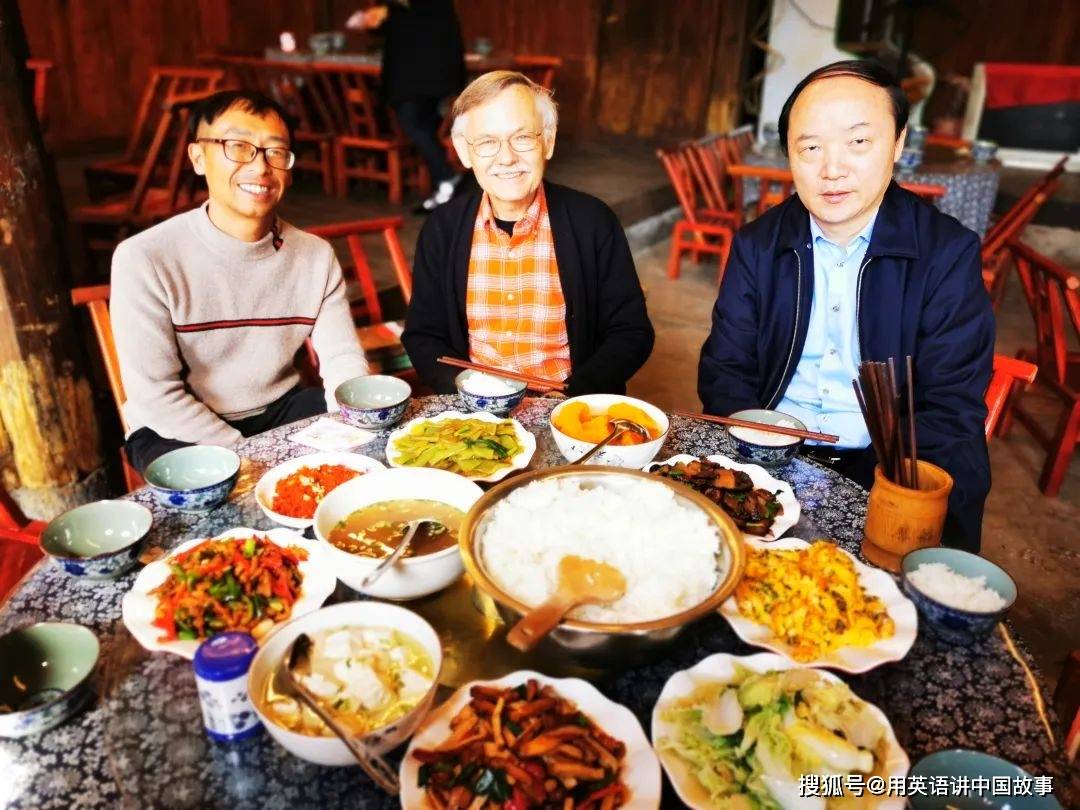老潘来信:乡村振兴,你我都是见证人!
2022-06-02 来源:搜狐网
故乡是每个人心中最柔软的地方,它承载着几代人的温暖记忆,是每个在外漂泊游子的情感慰藉。近年来,随着中国乡村振兴战略推行,“望得见山,看得见水,记得住乡愁”的美丽农村画卷正在铺展——
戈壁和荒漠变成良田,滩涂变楼房;崎岖的山地上修建起公路,大山里的百姓搬迁到了县城新房;特色农产品销往城市,人们过上了脱贫致富的好日子……乡村的变化记录着国家的发展与进步,其间的壮阔历程凝聚着无数人的智慧和汗水。
若要说起中国乡村振兴战略带来的改变,在中国生活了34年的老潘,可以说非常有“发言权”:上世纪八十年代,潘维廉第一次来到中国时,贫穷和落后,是他对很多地方的最初印象。1994年和2019年,他两次驱车环游中国,深入偏远的地区探访,亲眼见证了中国各地所发生的翻天覆地的变化。

“比起那些宏伟的桥梁和高铁,更让我感到诧异的是中国连农村都有水泥路、完备的电力设施和互联网。”正如潘维廉所感慨的,要让14亿城乡居民都过上好日子绝非易事,中国的乡村振兴之路让他看到了希望。今天,他把心中的千言万语,浓缩为这一封信,与我们分享一个外国人眼中的中国乡村振兴。
来信全文:
When I last visited Warsaw, an official boasted Poland was the only EU nation to avoid a recession during the 2007-8 economic downturn, and their economy had set an EU record with 28 years of growth!
我上次去华沙的时候,当地的一个官员跟我夸耀说波兰是欧盟国家中唯一一个没有受到2007年到2008年环球金融危机影响的国家,而且他们持续28 年的经济增长打破了欧盟的纪录!
One reason for Poland’s success was that, like China, they invested massively in infrastructure. This helped boost business and create the EU’s 6th largest internal market. Yet even as Polish leaders and academics boasted, rural people told me their lives had not improved at all because the focus was mainly on urban infrastructure that would generate a quicker return on investment.
波兰之所以能成功,其中一个原因就是他们和中国一样投入了大量资金在基础设施的建设上。这促进了商业发展,创造出了欧盟第六大的国内贸易市场。但就在波兰的领导人和学者夸夸其谈的时候,那里的农村居民却告诉我说,他们的生活根本没有得到改善,因为波兰政府把发展的重心放在了城市基础设施的建设上,以此来快速获得回报。
This neglect of rural areas is common throughout the world—except in China. Although I’m amazed by China’s bridges, highways and railways, any nation with money can build bridges. But China has what money cannot buy—a dream, and the determination that all people share in that dream—or “No one left behind,” as many 1st Party Secretaries told me. So more impressive to me than massive bridges are the concrete country roads, electricity and internet reaching even the remotest villages. I hope the rest of the world will learn from China. Otherwise, the world’s dream will only be a nightmare.
这种忽视农村地区发展的现象在全世界都很常见 —— 中国除外。虽然中国的桥梁、高速公路和铁路建设让人为之震撼,但任何一个有充足资金的国家都能建桥。不过,中国有着钱买不到的东西 —— 梦想,以及让所有人都参与到这个梦想中的决心 —— 就像许多政府官员告诉我的那样, “ 一个都不能少 ” 。所以比起那些宏伟的桥梁,更让我感到诧异的是中国连农村都有水泥路、电力和互联网。我希望全世界都能向中国学一学,不然的话,世界梦只会是一场噩梦。
In 1800, only 2% of people lived in cities. Today, 55% live in cities. In 33 years, the world population will grow 2.9 billion, as much as China and India’s populations today, and up to 90% will live in cities.
1800 年的时候,只有 2% 的人口居住在城市。今天,城市人口占了总人口的 55% 。而 33 年后,世界的人口将增加 29 亿人,这就和今天中国和印度人口总和差不多,而到那时候,高达 90% 的人将住在城市。
In 1960, Lagos, Nigeria, had less than 200,000 people. Lagos now has 21 million and expects 100 million people by 2100. And what kind of life will they have?
1960 年的时候,尼日利亚的拉各斯只有不到 20 万的人口。而现在,这个数字达到了 2100 万,而且到 2100 年的时候人口很有可能会突破 1 亿。那时候,他们的生活会是什么样的呢?
Even now, America’s neighbor, Mexico, boasts the world’s 15th largest economy but 60% of its people don’t exist on paper. They have no medical or retirement benefits, or education for their children. Compare this with China, which spends over 4 percent of its GDP on education, and the retention rate of nine-year compulsory education has reached 94.2 percent. “No one left behind.”
如今,美国的邻居墨西哥拥有全球第十五大的经济体,但 60% 的人口没有医疗或者退休补助,也没法让他们的孩子接受教育。与之相比,中国在教育方面投资了超过 4% 的 GDP ,而且中国九年义务教育巩固率已经达到了 94.2% 。真正地在实现 “ 不落下一个人 ” 。
Like the rest of the world, China has also faced rapid urbanization. Fortunately, it has both the infrastructure and the determination to succeed. And China also already has rich experience.
和其他国家一样,中国也面临着城市化的高速发展的现状。幸运的是,中国不仅有着完备的基础设施和成功的决心,还有着丰富的治理经验。
Over the years, I’ve visited many cities that emphasize a balance of “Garden City, Garden Countryside”. Their programs are so successful that many businesses relocated to rural areas where land is cheaper and workers can enjoy healthier, happier lives. And unlike Poland, even China’s remotest areas are benefiting because China’s focus is not on a fast return but a sustainable future for generations to come.
这几年来,我参观了中国的许多城市,他们强调 “ 花园城市 ” 和 “ 花园乡村 ” 的平衡。他们的计划非常的成功,许多的企业都迁入了乡村地区,因为那里的土地更便宜,工人也可以享受更健康、更快乐的生活。与波兰不同,中国最偏远的地区也是发展的,因为中国的重心并不是短期快速的收益,而是为子孙后代创造可持续发展的未来。
In 2019, New Channel’s Prof. Hu Min showed me around Changsha, 18 Caves Village and other areas of Hunan, and introduced me to Feng Yougen, who rose from poverty to become an entrepreneur and philanthropist. Mr. Feng said China’s future was in the less developed areas, not the cities that covered only 30% of China’s land. According to Feng, rural China is a “blank slate.”
2019 年,新航道的胡敏教授带我参观了长沙市、湘西十八洞村和湖南的其他地区,还向我介绍了冯友根先生。冯先生从贫困的农村中走出来,成为了一位企业家和慈善家。他说,中国的未来不是在占了中国 30% 的土地的城市里,而是在那些欠发达地区。他认为,中国的乡村还是一块 “白板” 。

老潘与新航道创始人胡敏教授(右一)在湖南湘西十八洞村体验乡村生活。
Fortunately, China’s leaders know exactly what to write on that blank slate. Let’s hope the rest of the world takes China’s lead.
幸运的是,中国人很清楚要在这块白板上面写些什么。希望世界上的其他国家也都能效仿中国。
我们看国家的变化,身在其中,会少一些强烈的对比,而老潘则从一个外国人的视角,让我们看到国家的进步,这是一种震撼。
如今,中国乡村振兴的发展经验,正在向世界展示。那么新一代的中国青少年是否准备好向世界分享中国发展成果,把本国的优秀文化和成就介绍出去呢?
相信在老潘的影响和带动下,“用英语讲中国故事”的队伍将不断壮大,会有越来越多的人参与其中,向世界讲好中国故事。


